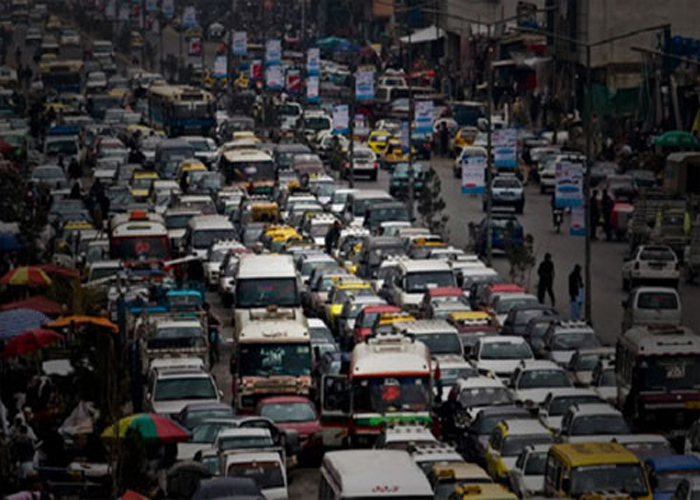Traffic congestion is one of the most chronic problems in the Kabul city which imposes additional cost on the already poor people. The f traffic congestion has inflicted different costs and implications on Kabul city and citizens such as extra cost of petroleum, increase in fare of urban transportation, waste of time as immaterial cost and production of more air-pollution in the city. In emergency cases, it imposes heavier material and immaterial costs on the people. For example, when a building or parts of city is caught fire, it takes long hours for firefighters to reach the destination. When there is a patient with critical condition such as heart attack, pregnancy or other urgent cases, it is too hard to rescue the lives of such patients. Given the current traffic jam it is possible that a pregnant woman given birth to her baby inside a car on the way to the hospital or die because of too much waiting or bleeding on the way to the health center. School students, public and private personnel often stuck for several hours behind traffic crowds. Sometimes it also causes serious psychological pressure on drivers because of waiting long time behind traffic jam. The drivers began to become impatient leading to behavioral violence, car accident and even road crimes.
To give a general picture, just imagine a city with the capacity of one or two million people became home to about seven million people while 90% of them are jobless or under poverty line. In order to earn a living, they come out to do business on the narrow roads and streets which are already full of traffic. The working vendors, carters and porters often occupy half-side of the roads while the half rest is occupied by the parked cars, especially near the large buildings, hospital and big markets.
Even. It is not surprising that corruption has also penetrated to these crowded roads and streets and so some of the street workers are called mafia of road. It is said that the mafia of road have link with police officials for taking the best location of roads and streets with hiring several poor vendors to run their businesses through different carters. This way, a number of them have reached to a very prosperous live in the capital city, but with cost of imposing heavy expenses on the citizens through increase of traffic congestions. The Traffic congestion affects not only the mobility of people and goods with aforementioned challenges but also affects on the air quality that leads to numerous deaths in the city.
The next problem which severely impacted the city is sound pollution in Kabul city. Unfortunately, the issue of sound pollution is not considered as a problem while the sound of cars, vendors, mobile businesses, mosque loudspeakers and so forth have annihilated the tranquility of the whole city. The families, the students, the researchers and the patients who need to a tranquil environment cannot tolerate to live near the public roads and streets houses. Unfortunately, the sound pollution is not limited to downtown of the city but also affected the residential areas. Every vendor or carter has a mobile loudspeaker keep calling for customers no matter where they are while according to health experts the frequent sound disturbance can lead to physical and psychological problems. Accordingly, the mosques also produce unnecessary sounds whenever they wish. In addition to five times call for worship which seems reasonable and acceptable for all, but they put out the sound of their praying, speeches and other religious programs while it is not justifiable by rational and religious logic. Based on Islamic teachings, anything when it imposes losses to others that is not permissible.
As above explained large parts of the aforementioned challenges are related to regulatory issues and traffic monitoring system pertains to the municipality of Kabul city. However, just the regulatory measures are not enough because Kabul city become overpopulated and current capacity of the city cannot accommodate all these populations. Therefore, the regulatory measures along with strategic measures are needed to rescue the paralyzed city. As a part of strategic measure, we must widen the current roads, implement new Kabul project (Kabul Jadid), constructing ring roads and also decentralize the public services to villages of the country so as to prevent from collective migrations to the large cities. As a part of regulatory measures, we need to organize the car and bus stations, traffic signs, vendors, carters, parking, old-aged cars and so on. We must note that the increases of old cars are considered as second polluting factors in Kabul which extremely intensified the problems of air-pollutions. It also high time to note that Kabul is the only capital in the world with no traffics signs, no bus stations and no serious monitoring system in the Kabul entry ways so as to prevent from entering dangerous things. However, some measures have been taken in recent years but they are not enough.
As immediate solutions, we need to follow several important points. Firstly, all hawkers or venders must be located to specific areas and leave the main roads anyway. There is no city in the world that main roads are occupied by hawkers. Secondly, all high story buildings are responsible to think about its parking space maybe through promoting the culture of rentable parking areas. Lastly, it is high time that Kabul municipality regulate the traffic signs, bus stations, street mafia and so sound pollution.
Home » Opinion » Why Kabul city engulfed in traffic swamp?
Why Kabul city engulfed in traffic swamp?
| Mohammad Zahir Akbari

